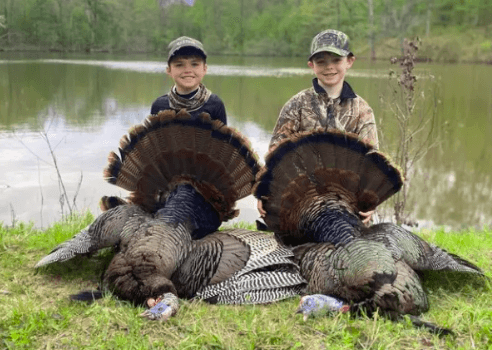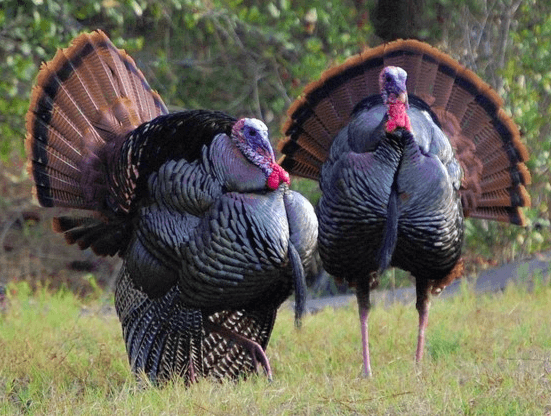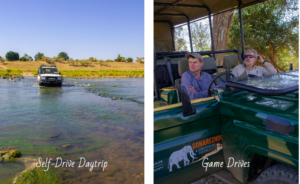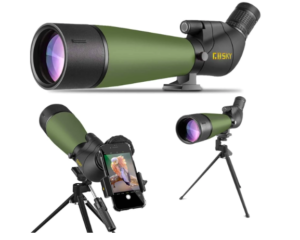
Arkansas Turkey Hunting Full Guide.
Turkey hunting in Arkansas is a thrilling and a popular activity for outdoor enthusiasts. The different landscapes of the Natural State, from lush woods to undulating plains, give the ideal setting for this exhilarating activity. Whether you’re a seasoned hunter or new to the sport, learning the restrictions, the best hunting seasons, and perfecting your turkey calling abilities are all necessary for a successful expedition. Arkansas is renowned for Bear and White-tailed deer and Elk hunting.
We’ll dig into the world of Arkansas turkey hunting in this guide, addressing frequently asked questions, offering ideas, and providing helpful insights. Our extensive information will help you make the most of your turkey hunting excursions in Arkansas, from the most recent season changes to methods for scouting and bagging that elusive gobbler. So gather your gear, put on your camo, and join me for a journey into the heart of Arkansas’ turkey hunting traditions.
How To Hunt Turkey In Arkansas Full Guide
Turkey hunting in Arkansas is a profitable and fun outdoor activity. To get you started, here is a detailed tutorial on how to hunt turkey in Arkansas:
1- Review the Regulations:
Examine the most recent Arkansas Game and Fish Commission (AGFC) turkey hunting laws. Regulations might change from year to year, so make sure you’re up to speed on bag limits, season dates, and particular laws for the region you’re planning to hunt.
2 – Obtain all necessary licences and permits:
Purchase an Arkansas hunting licence, as well as any extra turkey licences required. These are available for purchase online on the AGFC website or through authorised shops.
3- Essential Equipment
Shotgun or bow:
Choose your weapon based on your skill level and personal preferences. Popular options include shotguns loaded with turkey loads and archery equipment.
Decoys: Turkey decoys can attract birds in close proximity. For a more realistic arrangement, use hen and tom decoys.
Calls: Master the usage of turkey calls. Box calls, slate calls, and mouth calls are examples of common calls. Before you go out into the field, practise your calling skills.
Camo clothes: To blend in with your environment, use camouflage clothes. It is suggested to wear full camo, including face masks and gloves.
Blind or Camouflage Setup: To conceal from strong bird eyesight, set up a ground blind or create natural camouflage with branches and leaves.
4-Scouting and Planning
Scout Your Hunting Ground:
Before the season begins, spend time exploring the region. Tracks, droppings, and feathers are all signs of a turkey.
Study Turkey Behavior:
Understand turkey behaviours and routines, such as roosting, eating, and breeding tendencies.
5-Hunting Techniques
Roosting Turkeys:
Find roosting trees where turkeys sleep at night. Set up near these spots early in the morning as turkeys leave the roost.
Make use of decoys and calls:
Set up decoys to attract turkeys and simulate their noises using calls. Before making any moves, be patient and wait for a response.
Remain Silent and Unnoticed:
Turkeys have good eyesight. While you wait for your shot, remain motionless and well-hidden.
6-Practise Ethical Shot:
For a clean and compassionate kill, target the head and neck area. Avoid body shots, which might contaminate the meat.
7- After the Hunt
Tag and Check Your Harvest:
Immediately tag your harvested turkey and check it in according to AGFC requirements, which may include online or phone check-in options.
Processing Your Turkey:
Process your turkey as soon as possible to ensure that the flesh remains fresh. You may do it yourself or have it done by a professional butcher.
8 Report Your Harvest:
If needed by the AGFC, participate in turkey harvest surveys to aid in conservation efforts.
Remember to put safety first throughout your turkey hunt. Always notify someone of your hunting location and planned return time, and include necessary safety equipment such as a first-aid kit, a map, and a compass.
Turkey hunting in Arkansas may be an exciting experience, and with the proper preparation and information, you can have a successful and memorable trip.
Arkansas Turkey Hunting Laws.
Turkey hunting in Arkansas is governed by certain laws. Here are some crucial items to remember:
Season Dates:
The Arkansas turkey hunting season varies by zone. In 2024, for example, Zone 1 will have a season from April 15th to April 23rd, whereas Zone 2 will have a season from April 15th to May 5th.
Bag Limits: The statewide bag restriction is two legal turkeys per person, with no jacks permitted. There may be some exceptions. For example, in Zone 1, the restriction is one legitimate turkey with no jakes.
Checking Turkeys: Hunters are required to inspect their collected turkeys. This may be done right away via the Arkansas Game and Fish Commission’s (AGFC) website, mobile app, or phone. Hunters under the age of 16 must get a free Customer ID number.
Best Places To Hunt Turkey In Arkansas

Because of its diversified landscapes and large turkey populations, Arkansas has a plethora of ideal areas for turkey hunting. Here are some of the top areas in Arkansas to hunt turkey:
The Ozark National Forest:
The Ozark National Forest, located in northern Arkansas, provides several chances for turkey hunting. Its undulating hills, hardwood woods, and plentiful water supplies make it an ideal home for turkeys.
National Forest of the Ouachita Mountains:
The Ouachita National Forest, located in the western half of the state, allows hunters to pursue turkeys in a range of terrains, ranging from mountains to lowlands.
Black River Wildlife Management Area:
The turkey population in this area of northeast Arkansas is well recognised. Its mix of bottomland hardwoods and croplands makes it a popular turkey hunting site.
Hurricane Creek WMA:
Hurricane Creek WMA, located in south-central Arkansas, is well-known for its turkey hunting chances. It has a variety of ecosystems, including pine woods and hardwood bottoms.
Piney Creeks Wildlife Management Area:
Piney Creeks WMA, located in the Ozarks, has a combination of upland and bottomland woods, making it perfect for turkey hunting.
White River National Wildlife Refuge:
The White River National Wildlife Refuge in eastern Arkansas offers turkey hunting possibilities among its wide bottomland hardwoods and open fields.
Bayou Meto WMA:
Bayou Meto WMA in southeast Arkansas is known largely for waterfowl hunting, but it also provides excellent turkey hunting opportunities in its bottomland hardwood woods.
Mount Magazine WMA:
This location in the Ouachita Mountains offers a unique mountain turkey hunting experience.
Cypress Bayou WMA:
Cypress Bayou WMA, located in southwest Arkansas, has a variety of habitats and can provide good turkey hunting.
Sylamore WMA:
Sylamore WMA, located in the northern section of the state, provides turkey hunters with a combination of hardwood woods and clear streams.
Check current restrictions, get the required licences and permissions, and become acquainted with unique rules and hunting seasons for each place before venturing out to these areas. Consider contacting with local wildlife organisations or experienced hunters for the most up-to-date information and hunting tips in these areas.
Arkansas Turkey Hunting Seasons

Turkey hunting season in Arkansas varies by zone and often includes both spring and youth hunts. The following are the main dates for the Arkansas turkey hunting season:
Zone 1 Season (2024): April 15th to April 23rd.
Zone 2 Season (2024): April 15th to May 5th.
Statewide Turkey Bag Limit:
Hunters are permitted to take two legitimate turkeys with no jakes each day. Hunters aged 6 to 15 years old, including the youth hunt, may take one jake as part of their two-bird quota throughout the season.
These dates and bag limitations are subject to change from year to year, so before planning your turkey hunt, check the Arkansas Game and Fish Commission’s official website or other trustworthy sources for the most up-to-date information.
FAQ About Arkansas Turkey Hunts.
When is the Arkansas turkey hunting season?
The turkey hunting season in Arkansas varies by zone, although it usually takes place in April and May. Specific dates might change from year to year, so check the current restrictions.
What is Arkansas’s bag limit for turkey hunting?
In Arkansas, the bag limit for turkey hunting is usually two legal turkeys per hunter, with limitations on collecting jakes (young males). However, bag limitations vary by zone, so hunters should check the rules in their region.
Can I hunt using decoys and turkey calls in Arkansas?
Yes, turkey decoys and sounds can be used to attract turkeys in Arkansas. To maximise your chances of success, you must practise good calling tactics and strategically deploy decoys.
Is a hunting licence required in Arkansas to hunt turkey?
To hunt turkey in Arkansas, you must have a valid Arkansas hunting licence. In addition to a hunting licence, depending on the zone and type of hunting, you may require particular turkey licences.
In Arkansas, are there any limits on hunting near homes?
Yes, there are restrictions in place in Arkansas regarding hunting near dwellings. Hunters who use weapons within 150 yards of a dwelling or archery equipment within 50 yards of a residence, for example, must receive written authorization from the owner or occupier of that residence.
Can I hunt turkey on Arkansas public lands?
Yes, turkey hunting is authorised on public lands and wildlife management areas (WMAs) in Arkansas. It is critical to understand the precise restrictions and guidelines for the WMAs in which you wish to hunt.
Are there any age limitations in Arkansas for turkey hunters?
To harvest a wild turkey in Arkansas, hunters must be at least 6 years old. Young hunters under the age of 16 must also have a Customer ID number.
What are some good turkey hunting tips in Arkansas?
Proper reconnaissance, great camouflage, learning bird calling, and practising ethical shot placement are all required for successful turkey hunting in Arkansas. Patience and a grasp of turkey behaviour are also essential.
How do I report my turkey harvest in Arkansas?
Arkansas hunters can report their turkey harvest online via the AGFC website, using the AGFC mobile app, or by calling a specified phone number. Following harvest, immediate reporting is essential.
Can I hunt turkeys with a shotgun in Arkansas?
Yes, shotguns are often used for turkey hunting in Arkansas. Make sure your shotgun is properly loaded with turkey loads, that you observe all safety precautions, and that you are skilled at shot placement.
What are the legal shooting hours for turkey hunting in Arkansas?
The permitted shooting hours for turkey hunting in Arkansas are normally 30 minutes before sunrise to 30 minutes after dusk. However, always double-check the current season’s restrictions.
Are crossbows allowed for turkey hunting in Arkansas?
Crossbows are legal in Arkansas for turkey hunting. Make careful to observe all crossbow restrictions, including any special requirements for handicapped hunters.
Can I use bait to attract turkeys in Arkansas?
No, using bait to attract turkeys is forbidden in Arkansas. It is definitely forbidden to hunt over baited regions.
What is the minimum legal size for turkeys in Arkansas?
In Arkansas, the minimum allowable size for turkeys is normally a bird with a beard. Specific dimensions and any exclusions should be checked in the rules.
Are there any youth-specific turkey hunting opportunities in Arkansas?
Yes, Arkansas does provide possibilities for kids turkey hunting. These youth hunts provide young hunters the opportunity to learn and enjoy turkey hunting under unique rules.
Can I hunt turkeys on private property without written permission?
No, before shooting, fishing, or chasing wildlife with dogs on private property, you must receive formal permission from the proprietor or leaseholder. Certain family members may be exempt from this rule.
What are the penalties for violating turkey hunting regulations in Arkansas?
In Arkansas, violating turkey hunting restrictions can result in fines, licence cancellation, and other consequences. It is important to become acquainted with and adhere to all hunting rules and regulations.
Is there a set of guidelines in Arkansas for transporting harvested turkeys?
It’s critical to keep harvested turkeys properly tagged with your hunting information when transporting them in Arkansas. Follow the instructions for labelling, reporting, and storing your turkey.
Related Post.
- Moose Hunting in Vermont’s Breathtaking Wilderness; Majestic Pursuits
- Bear Hunting Vermont; A Comprehensive Guide.
- Exploring the Wilderness: Deer Hunting in Vermont’s Breathtaking Landscapes.
- Deer Hunting in Connecticut: A Guide to Seasons, Regulations, and Tips.
- Exploring Pronghorn Hunting States and Their Tags: A Comprehensive Guide.






